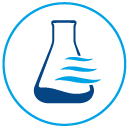
The Importance of Microbiology Testing in the Food Industry
1. Overview about Microbiology Testing
Microbiological testing in food safety management has two main strategies for testing food products. These strategies are:
- Determination of Microbiological Quality: This strategic test determines the total viable microbial count of the food sample. Testing includes – total bacteria count (TBC), total yeast and mold count (TYMC), and provides specific details about the food’s microbial quality.
- Determination of Food Safety: This strategic test involves food analysis and tests food samples for a variety of pathogens found in foods. These pathogens are most commonly Enterobacteria, Enterococci, coliforms, E. coli, Pseudomonas sp. Clostridia, Salmonella, Bacillus spp, Staphylococcus, lactic acid bacteria, Salmonella, Listeria, yeasts and molds, etc.
The results of these testing strategies help labs to identify and study:
- How different kinds of microorganisms such as bacteria and fungi lead to food spoilage.
- Identification of microbial contamination in food and food products.
- Methods and steps to prevent food spoilage as well as techniques for preservation.
- How to use various microorganisms in the production of food products.
2. The Importance of Microbiology Testing in the Food Industry
Food products provide all of the necessary ingredients for the growth of microorganisms. This microbial growth is catalyzed by certain factors inside the food like nutrients, pH, moisture content, physical structure of the food and/or by factors outside like temperature, relative humidity, and gases (CO2,O2). Microorganisms will grow very rapidly under optimum internal and external conditions, which results in the spoilage and degradation of foods leading to a sour, foul-smelling or fungus-covered food product.
When conditions in foods are ideal for microbial growth such activity may cause visible changes to the foods in color, in the appearance of powdery growth, in shiny coatings on food surfaces, etc. Microbial contaminations of food products during the food production process can occur at any time. However food spoilage is much more common and likely when foods are not stored properly, when they are not kept under heat or in cold/frozen storage and when there is a lot of moisture.
For food processing plants, food production lines, produce distributors, restaurants and any other food oriented industry it is vitally important to do regular food microbiology testing. These tests can save the food industry time, money, reputations, and will help keep the community healthy and happy.
3. Microbiology testing procedure & methods
Conventional microbiological testing in food safety management includes, enzyme-linked immunosorbent assay (ELISA), enzyme-linked fluorescent assay (ELFA), fluorescence in situ hybridization (FISH), and conventional, real-time, and multiplex polymerase chain reaction. Each of these conventional methods were developed to identify precise levels of foodborne microorganisms. Most of these methods require a 25 g sample of whatever food is being tested. It is also common for other tests to be conducted to confirm the results of the conventional tests. This is particularly true when dangerous microorganisms have been identified.
Laboratories that perform food microbiological testing follow a complex process involving many steps that adhere with the methodology accepted by the FDA and other organizations committed to food safety. Standard microbiological testing in food safety management procedures include careful weighing samples, standard dilution of each sample, pipetting of precise volumes into petri dishes, and the incubation of these dishes for specific times and at prescribed temperatures. Each of these steps includes a host of regulatory requirements to minimize variations of outcomes due to any irregularities in the process.
If dangerous microbes are found in a sample through the food microbiology testing process, laboratories move to the presumptive stage, in which a particular pathogen of concern is highlighted for identification. This identification requires another process in which the conditions for growth of the identified pathogen are enhanced while other microorganisms are inhibited. Once growth of the potential pathogen is accelerated and a sample is available, then it is carefully identified. Specific identifications are made using multiple methods including biochemical identification, mass spectrometry, serology and bacterial genetic analysis.
4. Conclusion
The truth is that most foods and food products supply an excellent environment for microbial growth which leads to spoilage and decay. There are a variety of factors, both intrinsic and extrinsic, that are responsible for the growth of microorganisms in food products. These factors include pH, temperature, salt and/or sugar content in the food, moisture content, etc.
Microbial testing of food involves the quality and safety analysis of the food samples.
Microbial contamination of food can be prevented by various methods such as physical removal of microorganisms, thermal treatment, freeze drying, addition of chemicals, radiation etc.
Keeping the food that people eat safe for consumption is necessary for a safe, healthy and trusting population. People want to trust that what they eat will not make them sick. This is why microbiological testing in food safety management through thorough and regular lab testing is standardized and regulated on state and federal levels. Keeping people safe and keeping our food industries flourishing and growing is fundamental to the work of food microbiology testing. Frequent and careful testing of food products keeps us all safer.
Torrent Laboratory provides microbiology testing and total analysis of a full spectrum of microscopic culprits including fungi, mold and bacteria. Our testing capabilities all use AOAC, FDA BAM, EPA and USDA-approved methods. We bring our years of experience in microbiology to offer a host of robust services and capabilities.






